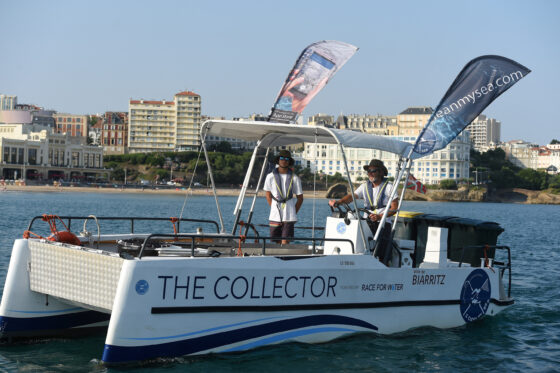
In Biarritz, a boat whose activity is financed by the city has been scouring the coast every day since early June to collect floating plastic waste that has accumulated on beaches taken over by holidaymakers.
baptized The collector, this catamaran-type boat is linked to a participatory mobile application (I Clean My Sea) that allows ocean users – sailors, surfers, swimmers or simple beach walkers – to report plastic slicks at sea.
“The two sailors on board the collector are notified, with the photo taken by the user and the GPS location”, explains Aymeric Jouon, an oceanography researcher and creator of the company that operates the boat, with the same name as the application. Thus, he hopes, with the help of users, “create a floating waste map in real time”.
This collection, to which the city of Biarritz spends 60,000 euros, is seasonal and adapted to the peak of tourist numbers on the Basque coast, explains Mathieu Kayser, Deputy for the Environment. “If we could, we would use the boat all year round, but that comes with a price”assures the chosen one.
The operation was carried out in previous years by another service provider, but this time the participatory aspect of the application is innovative, the deputy added.
On the beaches of Biarritz, the municipal employees also collect the stranded waste every morning, which has been brought along by the current.
“There’s always a little bit more waste every year, it’s a global consumption problem. We try to find all the solutions to cope, at our level”adds Mr. Kayser, who is hesitant to give numbers on the amount collected before the end of “The Collector’s” mission, in September.
“Square of the waterways”
The white catamaran, decorated with a blue wave, has a conveyor belt installed between the two hulls on which the water flow pushes the waste, which is then sorted by hand.
“80% of the waste is very fine plastics or microplastics, sometimes trapped in a pile of algae, so we try to sort”explains Valentin Ledée, 22, second-in-command.
With a landing net, he also catches everything that passes near the boat, such as at the foot of the cliff of the Biarritz lighthouse, in this bay opposite the casino and the Grande Plage, where the accumulation is more obvious.
Wind and tides also have an influence. “When there is a light westerly wind, it pushes the plastic back to the coast and when the water rises, it picks up everything that is on the banks or what has been deposited on the beaches”, says Aymeric Jouon. Thus Mathieu Kayser assures, “80% of waste collected at sea comes from land”.
The supply of waste from rivers and streams, such as the Adour, the Bidassoa or the Nivelle, is a headache.
“For me, the best course of action would be to focus on the mouths and crisscross the streams”, analyzes Mr Jouon. In the same way, the oceanographic researcher would like to be able to maintain his action in the winter, a season that produces even more plastic due to storms and floods, “but with much more complicated navigation conditions”.
Beyond the 300m stretch of coastline, where “The Collector” works, another boat criss-crosses the waters between the mouth of the Adour, at Bayonne, and the Spanish border, at Hendaye.
Commissioned by the Agglomeration Community of the Basque Country and the Pyrénées-Atlantiques department, it collected several tons of plastic waste in 2021.
(AFP)